
The ‘Switzerland of the East’, Jammu & Kashmir, offers outstanding opportunities for golf players all through the summer (April to November). Golfing in Jammu and Kashmir is always a delight and one of the main attractions among the tourists. Along with a number of adventure sports, Kashmir boasts of having one of the world's highest green golf courses, as well as a clubhouse , at Gulmarg. Kashmir is known for some of the greatest and most celebrated golf courses in the world, surrounded by chinar and pine trees.
Gulmarg Golf Club was established in 1904, by Sir Neville Chamberlain. Later it was redesigned by the famous golf architect, Peter Thompson. Gulmarg Golf Club has one of the highest golf courses in the world. Its 6760 yards long golf course, par 72 with 18 holes boasts of having India's longest hole, a par five, 610 yards. The club provides proper facilities of a bar, library, lounge, table tennis, lawn tennis and lots more. The golf course is generally active in the months of April to November.
Kashmir Golf Club, 3730 m above sea level, is another popular destination among golfers. Located near Maulana Azad Road, the City’s main avenue, it has an 18-hole professional golf course, spread over 52 sprawling acres of lush greens. The course has all kinds of excellently fitted equipment that makes playing golf an unforgettable experience.
Golfing is a sporty rejuvenation at Royal Spring Golf Course. The huge golf course, covering an area of about 300 acres, is built near the famous Cheshma Shahi Gardens overlooking the picturesque Dal Lake. The Royal Springs Golf Course was designed by the world famous Golf course architect, Robert Trent Jones Jr. II. Robert is credited for designing about 500 golf courses all around the World. The perfect location of Royal Spring, against the scenic backdrop of the Zabarwan hills, provides a, exhilirating experience to the golfers and nature lovers.
Gulmarg and Srinagar are the best spots where one can find the world's most refreshing golf courses. One can play for longer hours in these golf courses in comparison to that of the plains because of the lower temperature at higher altitudes.
The golf courses are well equipped with facilities for both beginners and experts. Proper instructors are available for beginners. The J&K tourism department provides all kinds of facilities for travellers and golf lovers.
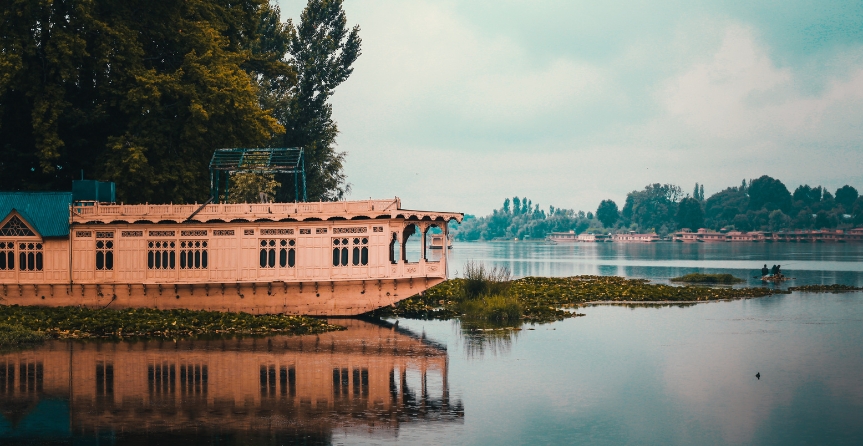
The Floating Luxuries
The area now known as Kashmir valley was originally a vast lake called satisar.After the lake got drained River Jhelum originating from verinag and flowing down into Pakistan bisecting the valley led to some smaller lakes here and there existing in the valley. Fishing and other trades allied to rivers and lakes were amongst the chief professions of the first settlers in the valley. Living in boat therefore is very old tradition prevalent from ancient times.
With the passage of time and through human ingenuity the boats were primarily covered with thatched roofs to protect the dwellers from sun, rain, snow and cold. This later got developed into the Doonga, which a boat structure all is made of wood. High at the center to make a single roof inclined on both sides, with compartments to serve as the residential units also housing a kitchen within.The decks in front and rear are conical in nature which serve as the entrance to the Doonga. The maximum width of a Doonga boat is 7 to 9ft.
The Moghuls who felt discomforted by the heat and dust of the Indian plains sought refuge in this beautiful valley where they laid out several pleasure gardens. Moghul kings and chiefs used the Doongas for pleasure trips to various scenic spots which provided a nice floating hall for feasting, music and merry, making excursions and lakes bathed in moonlight regular affairs.
During the British rule in India, the Britishers in their early years used to come to Kashmir from Rawalpindi now in Pakistan. All the way about 165 miles Akkas .Horse carts up to Baramulla, a district now about 45 kilometers in the west of Srinagar. From Baramulla the would sail up in Doongas which involved about 2 and half days to reach Srinagar for holidays in and around Kashmir. Though the British wanted to build houses here but found the political set up averse to such a proposition. Hence house boats as Doongas were introduced as an alternate residential and tourist attraction. They preferred to stay in Doongas boats instead of houses, because they could be shifted to the different picturesque and interested spots easily accessible through the river and lakes system in the valley.
Growing interest and number of British and other European visitors necessitated and incited further improvement of residential boat houses. General Dunlop of the British army, who got a boarding Doonga “Mermaid” build himself, is said to be the first in making a sketch of a houseboat containing wooden walls, windows and a deck. This gave birth to the first version of houseboats with two three bedrooms, a living cum dinning room, baths, small rectangular front and rear decks. The length of the houseboats then ranged between 80 to 100ft and the width 10 to 20 ft having passages from room to room. Furnishing with carpets Indian Durries, mat curtains, walnut wood furniture’s and so on began.Inclined Doonga roofs were substituted by flat roofs to create flat sun decks fit enough for sun bathing, parties and cook tails. The Doonga boats now served as the kitchen and the house to reside in the houseboat owners and associated caretaking staff of these modern houseboats.
Kennard a British army officer, joined by a local Kashmiri pandit Naraindas helped in constructing the first houseboat called “Victory” which was completed in 1888.Afterwards naraindas himself took to building the Houseboats as he found it a profitable business.
In 1918, the then Duke of Connaught got the first double storied houseboat built which gave way in 1947.
During the Second World War an increasing number of Britishers from the Allied countries came to Kashmir for prolonged holidaying.Houseboat accommodation got in great demand. Crude small boats for crossing to and fro attached to Doonga boats have accordingly received the boat owners due attention.Fully spring seated shikaras with curtains and cushions, similar to Egyptian Gondolas have come to replace crude unfurnished boats.Each houseboat has a shikara attached to it for going back and forth from the banks.Also meant for relaxing and soul refreshing rides and excursion.
Since Kashmir’s accession to India in 1948, tourist traffic to Kashmir’s both foreign and domestic has grown tremendously and the houseboat industry in Kashmir side by side has made great leaps forward. Enterprising and commercially sharp houseboat owners have constantly engaged themselves in enlarging their fleets to meet the challenge posed by increasing tourist inflow and in equipping the houseboats with sophisticated and modern amenities and furnishings to position these as modernized hotels. Some of the houseboat accommodations today stand second to none in comfort, luxury and grandeur, and some even surpass in setting and stand toe to toe with any hotel accommodation in India.
Staying in a houseboat is staying in a home far away from home. You get homely atmosphere, meals as per your choice. Continental, Indian, Chinese, Kashmiri Wazwan and local meals are also served in these house boats.
There are about 1000 houseboats available and registered with the department of Tourism in the twin lakes of Dal and Nageen .They belongs to various categories from Luxury to A, B, C as per their merit and the tariff of the houseboats is accordingly fixed. One can see the floating vegetable flower markets besides oneself while enjoying a shikara ride in and around Dal Lake. The trip of a tourist in the state is incomplete without experiencing a stay in the houseboat.
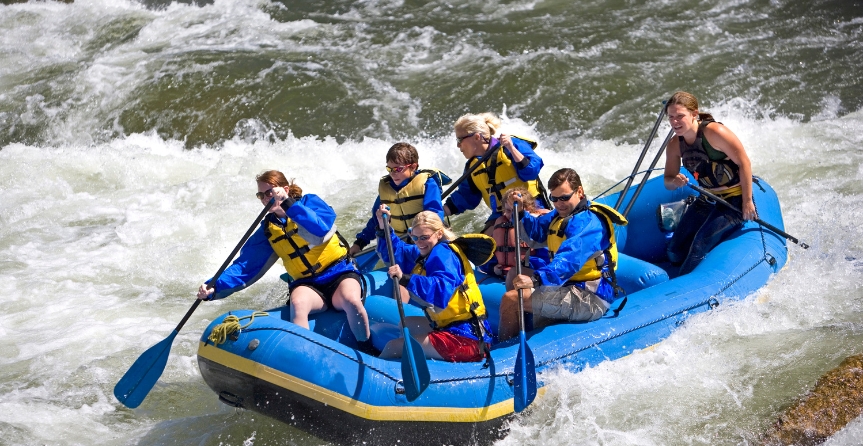
Jammu and Kashmir is a complete package tourist destination in terms of natural beauty, historical monuments and even adventure sports. Having some of the most renowned rivers, lakes and waterways,J&K offes the best water and adventure sports. River Rafting is among those wonderful sports that take you to great heights in the Himalayas, from where the snow-fed rivers tumble down to the plains of India. The sport attracts a number of domestic as well as international tourists. If you are the one who loves thrill, excitment, speed and adventure, river rafting is the perfect sport for you.
The state has several river-rafting clubs that offer the thrill of rafting in the fast flowing mountain rivers. Experienced trainers are also available. Summer is the best season to try out this sport. As the snow melts in summers, the volume of the river water increases. The rivers like Beas, Sutlej, Chenab, and Spiti are the best for rafting. One needs to take prior permission from the government authorities to go river rafting in the region. The challenging river rafting destinations in J&K are comparable to the best in the world.
It is recommended to take expert rafters and all the essential gears and equipment while going for river rafting at higher altitudes. Rescue back-up is very essential for this white water expedition.
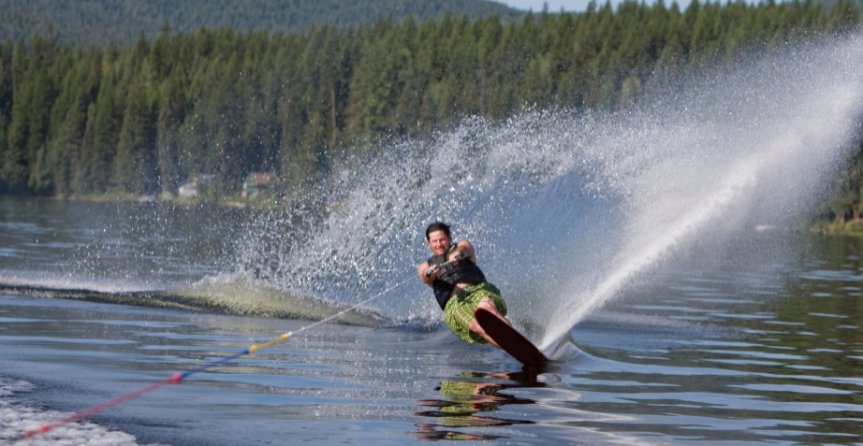
Water Skiing, like Ice Skiing, is a major extreme sport in the state of J&K. The sport is a major attraction for water sport lovers to make a splash on the watery. Sliding over the water surface requires balancing on the ski board, somewhat similar to surfing. Although water skiing is an expensive sport, it has tremendous potential in the tourism sector.
The Dal and Nagin lakes in Srinagar and the Manasbal Lake (32 km from Srinagar) are the most popular destinations for water skiing in the state. Tourists can hire 'bathing boats' along with motor launches, water-skies and trained instructors at the Dal Lake. Trained instructors and all such facilities are also available at the Nagin Lake. It has a larger number of bathing boats, and a government-run Institute of Water Sports too. Nagin lake is more popular for water skiing because of its clean water. Apart from this, another natural treasure located in isolation is the Manasbal Lake. The lake, surrounded by the hills on three sides, displays a mirror like sheen on its surface making it an attractive water sports resort. One can avail all sorts of latest water skiing equipments as well as specially trained instructors at Manasbal Lake.
Specially designed skis are fitted with flexible rubber foot bindings on the upperside, and fins on the underside to provide stability while sliding over the water surface. These fins also help the skier to take sharp turns. Bare foot skiiing requires very high speed motorboats. Because of the absence of high speed motorboats, it is not possible in Kashmir presently.
Inter-School, Inter College and even National Level competitions are organised to promote the sport and make it popular in India. The J&K Water Skiing Association also organises training camps and competitions every year. The lakes are pleasant throughout the summer season for water skiing.
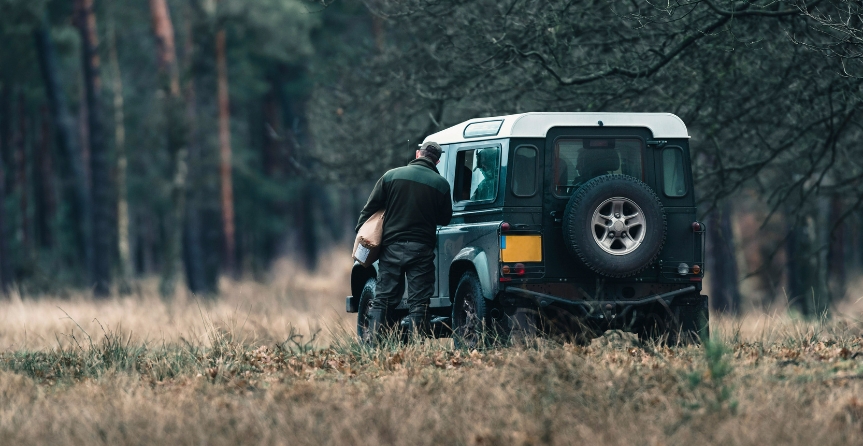
Jeep Safari
Wish to explore the wilds or the remote snowy areas of the Himalayas?- the best option is to board a jeep. It is the most secure way to travel while exploring the wild species in the dense woods or driving over rocky hills. Jeep Safaris prove to be the best way to get an inside look of the forests and its topography. Jeeps provide comfort amidst every adverse situation, be it the narrow mountainous highways even.
While enjoying a jeep sfari, one can discover the hidden mysteries of the Himalayan region. Starting from religious temples located atop the high mountain ranges to the distinct and endangered species of the wilds, a Jeep takes you wherever you want to go. Undoubtedly, trekking is an adventurous way to explore the region, but as it is restricted to the relatively healthier people, the Jeep Safari comes in handy for one to access a desired dream destintion.
Jeep Safari in the Trans Himalayan region unfolds the natural, and man made wonders situated within the picturesque landscapes. The Tourism Board of India offers jeeps, trained drivers and guides to the high altitude destinations of Leh, Ladakh and Kinnaur- Spiti. The most popular route of a jeep safari in the region is a drive to the Pangong Lake. A four-hour drive from the Pangong will take you to the Changla Pass. The journey offers an extraordinary scenery with crystal clear waters of the lake, and white mountains with golden yellow sunshine.
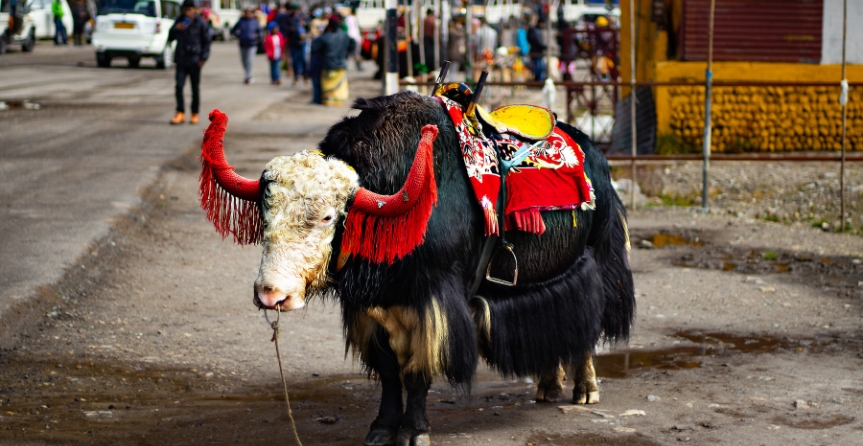
Yak Safari
The Ladakh region of the state of J&K is also popular for the Yak Safari. Yaks, the domestic animal of Ladakhis, is a highly valuable animal in the Himalayan economy. The beast not only carries loads but also ploughs fields. Yaks, basically a wild ox, are the largest animals of this cold desert. Exploring the valley on the back of Yak is truly a fun experience. The beast takes you to the lakes, lacier valleys, gurgling streams, cascades, snow peaks, meadows, and dense forests. Anyone can enjoy this Yak safari on prior booking.
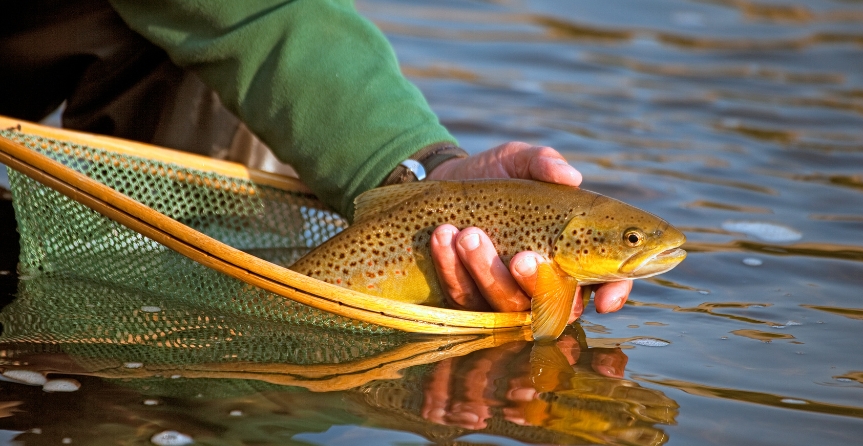
The beautiful geographical variations of the state of Jammu and Kashmir, along the course of each river and lake, offer endless possibilities for anglers. The various waterways, crisscrossing the state, are important fishing retreats rich in trout. The state of Jammu and Kashmir is known as a paradise for fishing enthusiasts. The streams and lakes have plenty of brown and rainbow trout, but it is necessary to have a permit to go fishing. The credit for introducing these brown and rainbow trout to the streams of Kashmir goes to the British.
The wide silvery network of rivers and streams as well as high altitude lakes, including Sind and Lidder Rivers, Dal Lake, Jhelum River, etc. abound in trout- both brown and rainbow. The region with pure mountain air, serenity, tranquility, lush meadows and magnificent clear lakes with a series of tributaries and streams offer the best experience of trout fishing. Most of these rivers are covered with snow,which start melting between the months of May to July. The activity is a once in a lifetime experience.
Kashmir's trout fishing is relatively cheaper than any other part of the world. Moreover, the Department of Fisheries works hard to prevent the depletion of fish stock by indiscriminate fishing. The main fishing business starts with the arrival of spring and summer (the season is from April to October). Local guides accompany amateur fishing enthusiasts on Shikaras and teach them how to net fish. After an amazing experience of trout fishing, one can enjoy night camping and bonfire near the rivers/lakes along with delicious meals.
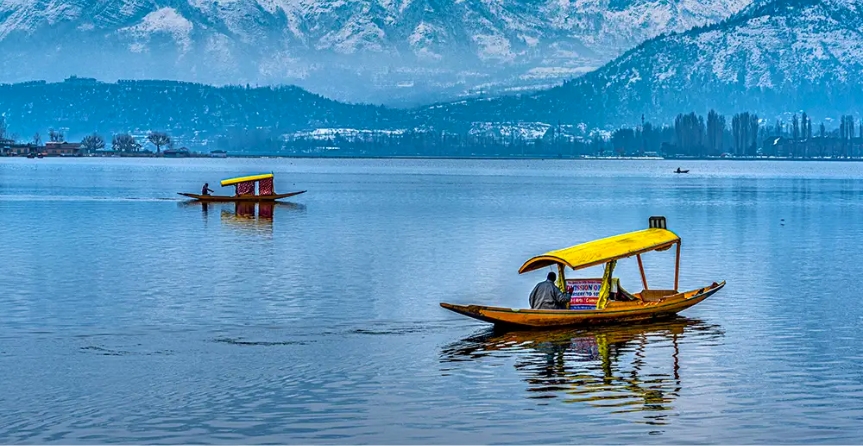
Visit the water bodies in the lower Shiwalik Himalayas, Kashmir valley and the high mountains of the Kashmir Himalayas for a complex and vibrant ecosystem. The center of life for the inhabitants of the state, these lakes are credited for the emergence of a unique culture of the state of J&K. One can almost see the whole city travelling through these lakes. These tranquil and snowy lakes have been a major attraction of this paradise on earth. Surrounded and protected by the Himalayan Mountains on all sides, these natural treasures offer a unique experience of living on water in the specially designed houseboats. Several scenic lakes with multi-faceted eco-system and grandeur, which epitomize the state of Jammu and Kashmir are-
Dal Lake
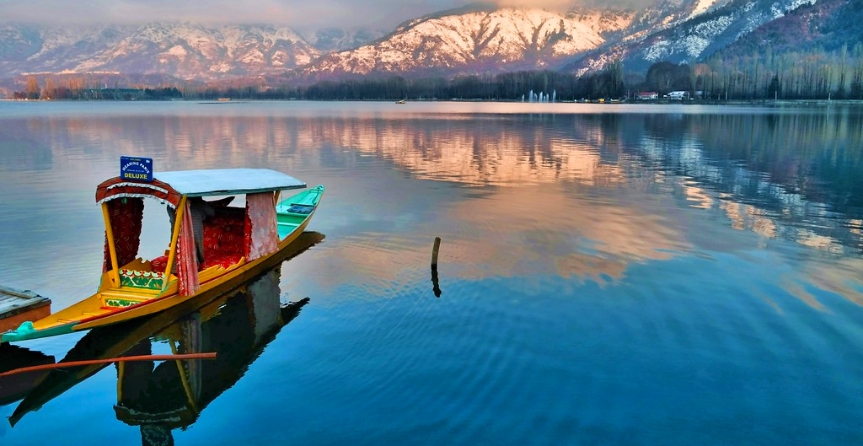
Popular as the jewel in the crown of Kashmir, the Dal Lake is the most famous and most visited lake in the state. Lined with Mughal-era gardens, the lake is rich in lotus, water lillies and water chestnuts. It is among those major destinations that let you free to enjoy life on water in the houseboats. One can have the pleasure of Shikara rides, kayaking, canoeing and other water activities in the al. Surrounded by mountains on three sides, the lake gives a paradisiacal view when frozen in winter.
Nagin Lake
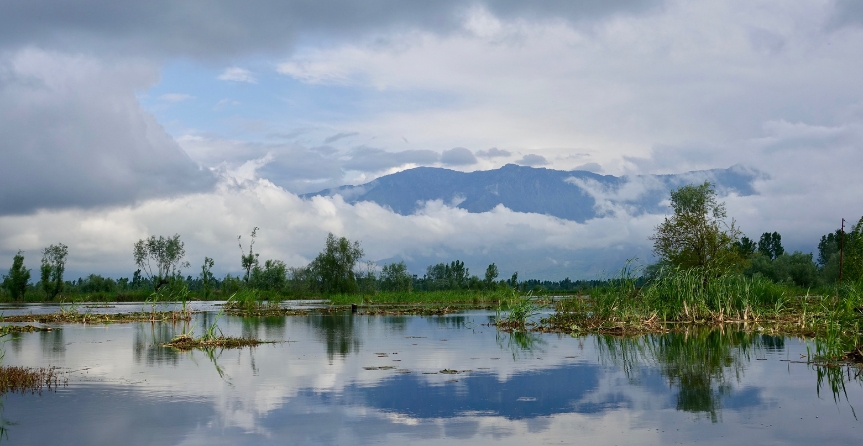
Located east of Kashmir, the lake lies on the foothills of the mountain Zabarwan. A number of willow and poplar trees lining the lake, Shankaracharya hill on the south and Hari Parbat on the west provide a charming view to the surroundings. Along with several water activities and Shikara rides, one can also hire boats, a romantic experience. Several salesmen can also be seen selling fruit, nuts, fresh flowers, baked goods, woolen shawls, silk carpets, leather goods and other materials on their boats.
Wullar Lake
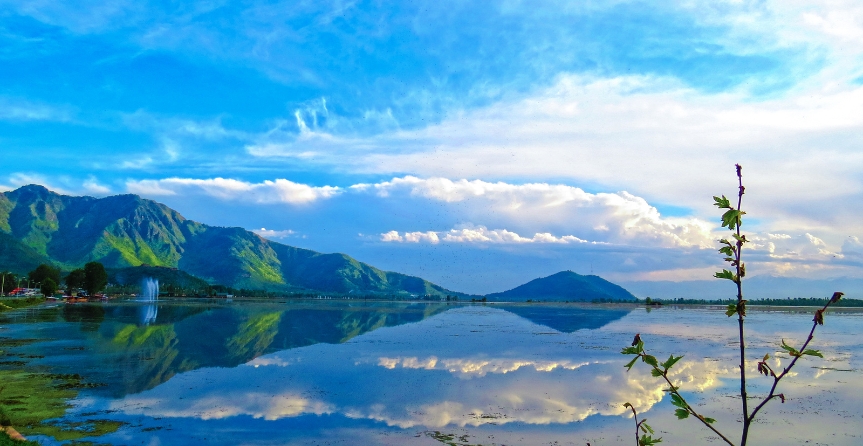
With a width and length of approximately 10 and 24 km respectively, Wullar Lake is one of the largest fresh water lakes in Asia. The lake gives about 60 percent of the fish yield of the region. Its perfect location between the cities of Sopore and Bandipore provides a marvellous view of the majestic hills on one side and steep valleys on the other. Wullar Lake, which draws water from the northern river Jhelum, lies at a distance of 60 km from Srinagar. Moreover, a renowned bird watcher's paradise, Nal Sarovar Bird Sanctuary is also situated near the Lake.
Surinsar Lake
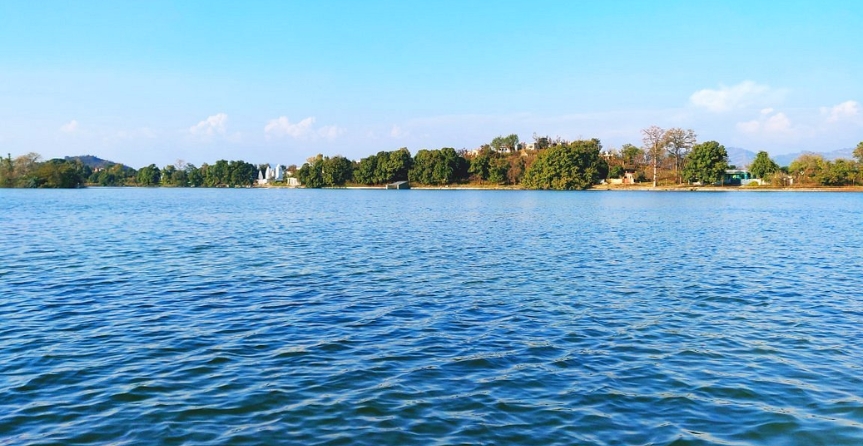
With wooded hills all around, thick forests in the backdrop and countless lotus flowers on the surface, the beautiful Surinsar lake is a great picturesque tourist spot situated about 42 km from Jammu. The lake appears like a lotus garden in summers. The lake is a much sought after by nature lovers. According to Hindu mythology, the lake originated when Arjuna, the hero of the epic Mahabharata, shot an arrow to the land.
Mansar Lake
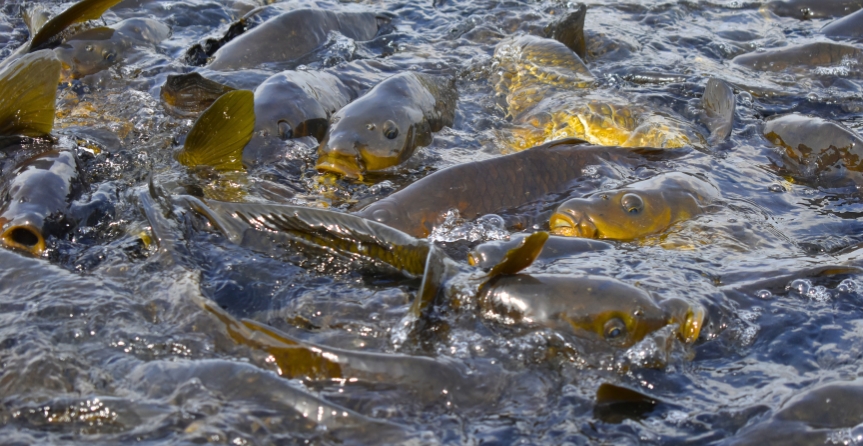
Popular for the food and crafts festival, the Mansar lake draws thousands of tourists every year around Baisakhi. Apart from the scenic beauty and landscapes, the lake has several religious values too. Situated about 40 km south of Udhampur, the Mansar lake is surrounded by dense forests and hills. The lake is counted among major tourists destinations because of boating facilities and its religious values owing to Sheeshnag shrine. Newly wed couples perform three 'Parikramas' (circumambulations) around the lake to seek the blessings of the lord of serpents. Flickering of seasonal birds, tortoise and fish of different species can be observed while boating in the calm Mansar lake.
Pangong Lake
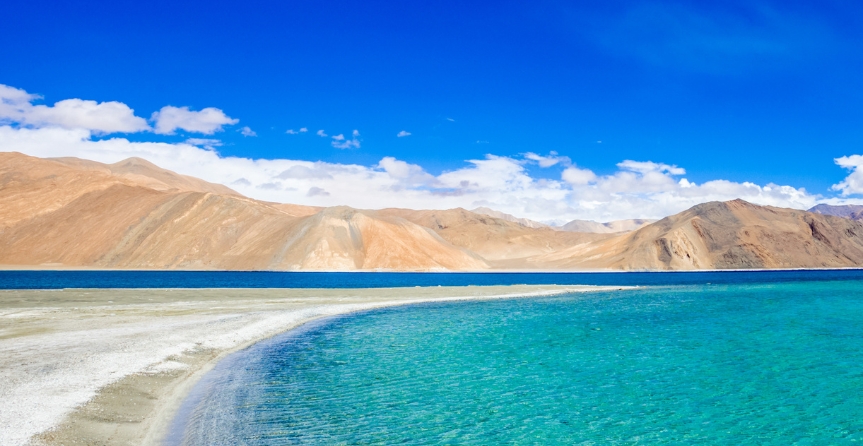
Located in an isolated area at a 5 hr drive (160 km) from Leh, this 134 km long lake extends from India to China. Tourists mostly visit this lake during May to September with a special permit. The Pangong lake boasts of being the world's highest brackish lake at a height of about 4,250 m (13,900 ft) from sea level. Villagers can be seen with their large herds of Pashmina sheep and long-tailed yaks. Despite being a salt water lake, it surprisingly gets frozen in winter. With such a wonderful location and a scarcity of oxygen, the Pangong Lake is a geologist's domain too.
Tso Moriri Lake
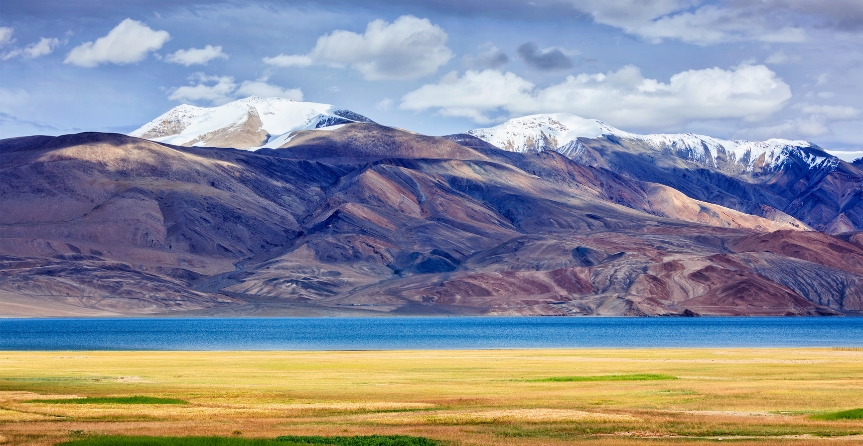
Providing a majestic natural view of Ladakh in the north, Tibet in the east and Zanskar in the west, Tso Moriri lake is mostly visited in summer. Changthang plateau, with snow peaks, provides the source of water for the Lake. The lake is popular for being the largest of the High Altitude Lakes in the Trans-himalayan region, entirely within India. It was earlier a salty lake whose salt was xtracted by the end of 1959 for the consumption by the local people. Tourists flock to the lake to visit the Korzok Monastery, situated on the western bank of the lake, believed to be about 400 years old.
While on a tour to the lakes of Jammu and Kashmir, you may also visit the Tsokar Lake and the Gangasagar Lake. Tsokar Lake is popularly called the “White lake” because of the salt content in it. Situated approximately 45 km northwest of the Tsomoriri Lake at a height of 4,485 m, the Tsokar lake covers an area of about 10 sq km. The whitish surface of this lake is the main element that makes it so charming and attractive. The local people extract salt content from the lake .The Gangasagar lake is an artificial lake, which is believed to have been constructed during the time of Sivaji’s coronation with the holy water of river Ganges. The lake provides an enchanting view of the Raigad Fort and the snow clad peaks forming the backdrop. These waterways, surrounded by majestic mountainous ranges, form the uniqueness of the state of Jammu and Kashmir with their charming houseboats, blossoming gardens, and water sports activities. All these specialties are ideal to make your holiday memorable for a lifetime.
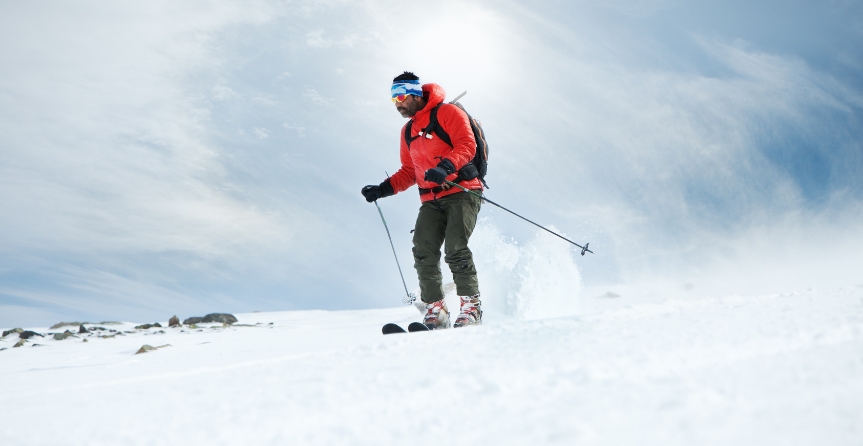
Mountaineering, in India, came as a sport in the 18th century with the Europeans. During that period, the entire Europe indulged in exploring new regions. Earlier, this activity was meant to climb difficult heights and terrains to meet people across the border, to trade, or to conquer new territories. The zeal of taking up challenges led man to accept this daring and adventurous activity as a sport. For the purpose, the Himalayas proved to be most suitable destination. New heights were conquered and new routes were discovered. Today, people have started taking mountaineering as a serious hobby.
Mountaineering In India
The challenging peaks of the Himalayas offer endless adventure, cultural learning and recreational opportunities. Mountaineering in the Himalayas on some of the world's greatest peaks is a lifetime experience. Kashmir, Zanskar, Kishtwar and Ladakh are the four zones in the state of Jammu and Kashmir that are important for mountaineering. Pahalgam, Gulmarg, Sonamarg and a few other places serve as the base camps for tours to the mountain peaks. Scaling high altitude mountains is gaining popularity among the youth. Even amateur mountain climbers wish to enjoy mountaineering trips and expeditions. One needs to take permission from the Government of India through the Indian Mountaineering Foundation (IMF) for mountaineering in Kashmir.
The months of May to October are considered best for mountaineering in J&K. With the constantly growing tourism industry, and craze for adventure sports, the peaks in J&K are frequently visited by the tourists.Nun and Kun, popular romantic-adventurous peaks, in Zanskar region are renowned summits with the mountaineers. Lahaul and Spiti in Leh also have several challenging peaks. Nubra Valley, about 10,000 feet above sea level in Ladakh, is also frequently visited by adventure enthusiasts. The mountains vary in their altitude and even geographical structure (snowy or rocky). The most popular mountaineering peaks, categorised in different zones, are:
Zanskar region:The famous peaks of Nun 7135m, Kun 7077m, White Needle 6500m, Pinacle 6930m and Z-1 6400m. Besides, Z-2, Z-3, Z-8, D-41, N-8, and Bien Guapa are a few other peaks ideal for mountaineering.
Ladakh region:Stok Kangri 6153m, Parcha Kangri 6065m, Kanglcha 6700m, Gulap Khangri 5900 m, Matho West 5950m and Kantak 5275 m.
Kishtwar region: Sickle Moon 6575 m, Riger 6,001m, Brammah-I 6416m, Crooked Finger 5630m, Arjuna 6230m, Katori 6138m and Flat Top 6100m.
Kashmir Valley: Kolahoi, Harmukh, Tattakuti, and Sunset (highest peak in the Pir Panjal range).
Sonamarg: Kolahoi 5425 m and Harmukh 5148 m.
For the amateurs, there are a number of un-named peaks in the altitude range of 5,500 metres and 6,400 metres in the same regions.
These mountaineering tracks pass through green forests, waterfalls, pilgrim routes and other splendid locations. While mountaineering, one can explore the monasteries and villages at an altitude of about 13,000 feet in Ladakh.
There are certain guidelines to be followed for mountaineering. The sport should normally be undertaken by the people between the age group of 18 to 48 years. It can be dangerous for the people suffering from high/low blood pressure, asthama or overweight. One should get his/her medical fitness test done before hand and should learn how to deal with high-altitude sickness. It is suggested to carry necessary medicines and not to try mountaineering before proper training.
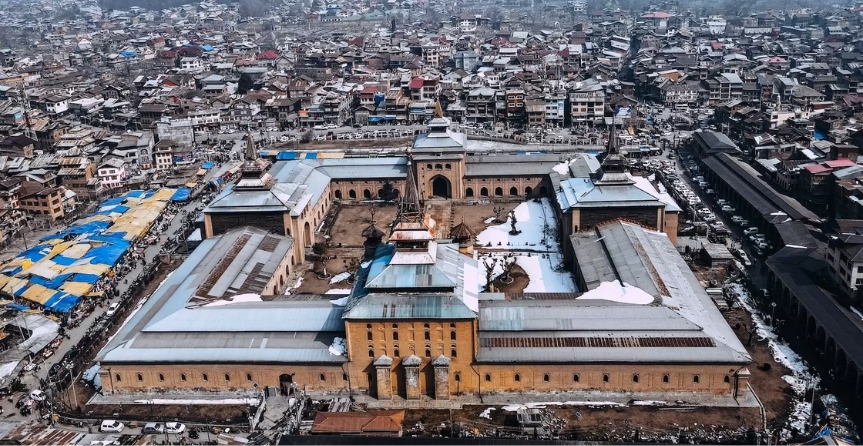
Srinagar
This place is also known as the 'City of Lakes' and it has a very pleasant weather. This city contains the world famous Dal Lake. The other tourist spots are the Hazratbal Shrine, Jamia Masjid, Khanqah Moula and the Mughal Mughal Gardens. The district of Srinagar is situated on either sides of the Jhelum River, making its locales picturesque and beautiful. The major attractions of Srinagar travel include Dal Lake, Nagin Lake and the old city. The Mughal Gardens set up by various rulers of the Mughal dynasty further enhance the beauty of Srinagar. Other major draws of Srinagar are water sports activities, hand crafted souvenirs and amazing nearby resorts.
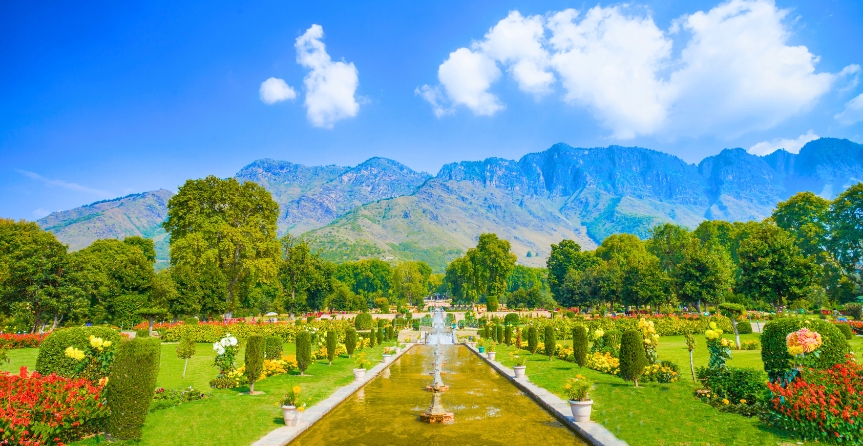
Mughal Gardens
With terraced lawns, cascading fountains, paint-box- bright flower beds and the panorama of the Dal in front of them - the three Mughal Gardens of Chesmashahi, Nishat and Shalimar are the Mughal Emperors' concept of paradise and are today very popular places for picnics and excursions.
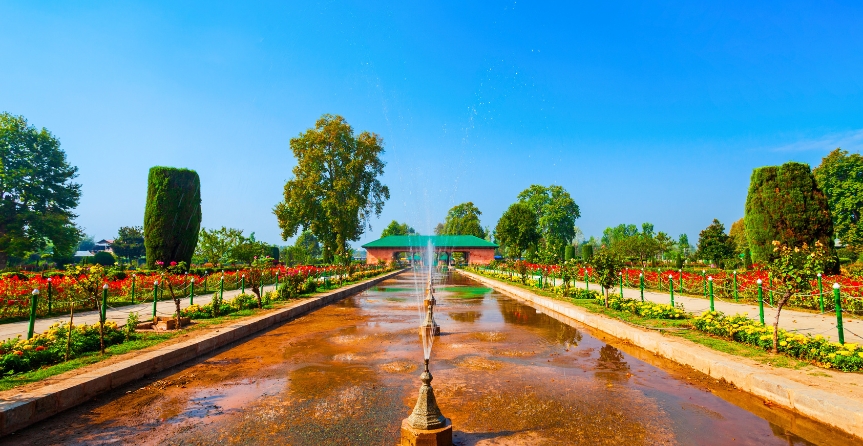
Nishat Bagh
Situated on the banks of the Dal Lake, with the Zabarwan Mountains as its backdrop, (11 km from Tourist Reception Centre), this 'garden of bliss' commands a magnificent view of the lake and the snow-capped Pir Panjal mountain range which stands far away to the west of the valley. Nishat was designed in 1633 AD by Asaf Khan, brother of Nur Jehan.
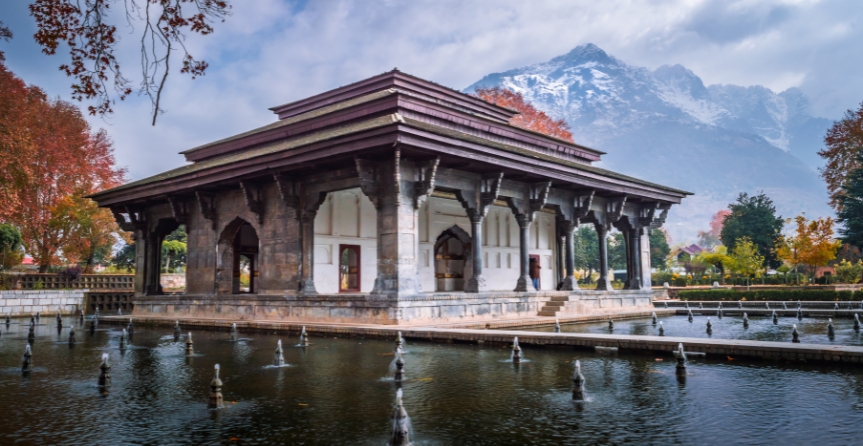
Shalimar Bagh
Built by Emperor Jehangir for his wife Nur Jehan, Shalimar, 15 km from the Tourist Reception Centre, is a beautiful garden with sweeping vistas over gardens and lakes, and shallow terraces. The garden is 539 m by 182 m and has four terraces, rising one above the other. A canal lined with polished stones and supplied with water from Harwan runs through the middle of the garden. The fourth terrace, by far the best, was once reserved for royal ladies.
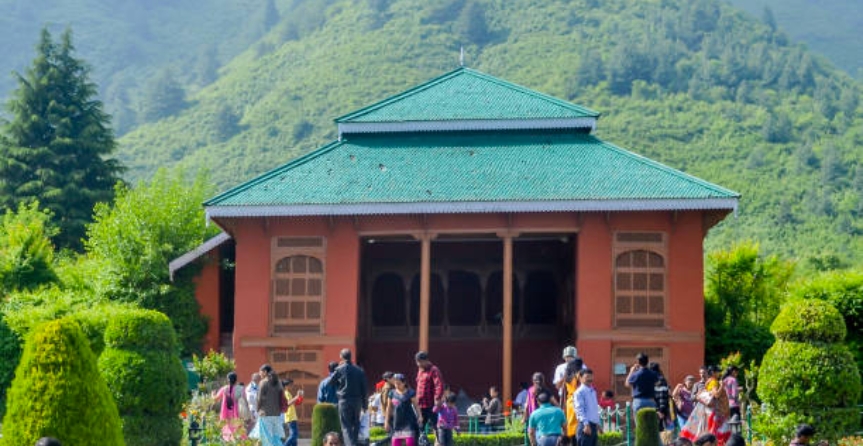
Chashma Shahi
Chashma Shahi is tastefully laid garden in terraces, which commands a magnificent view of the Dal Lake below and surrounding mountain ranges. The cool water of the spring is highly refreshing and digestive. The original garden was laid out by Shah Jahan in 1632 AD.
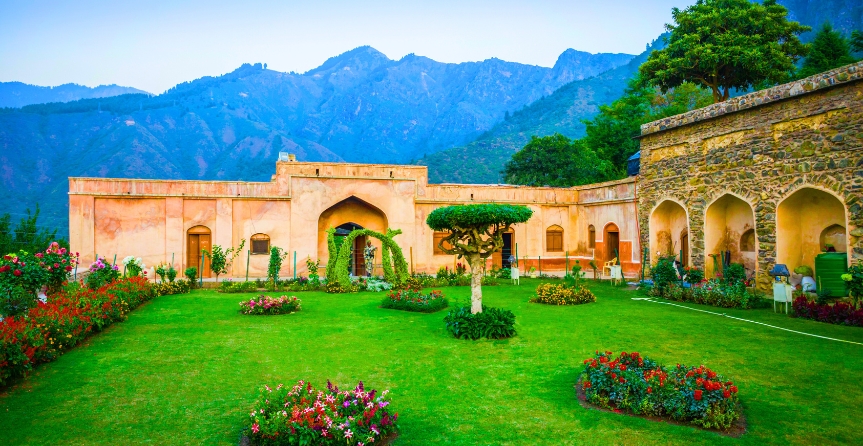
Pari Mahal
Once the royal observatory, Pari Mahal has a charmingly laid out garden and is a five-minute drive from Cheshmashahi. A Buddhist monastery at one time, it was converted into a school of astrology by Dara Shikoh, Mughal Emperor Shah Jehan's eldest son. Situated on the spur of a mountain overlooking the Dal, the ancient monument, with a well-laid spacious garden in front, is connected to Cheshmashahi by road. It is illuminated at night.
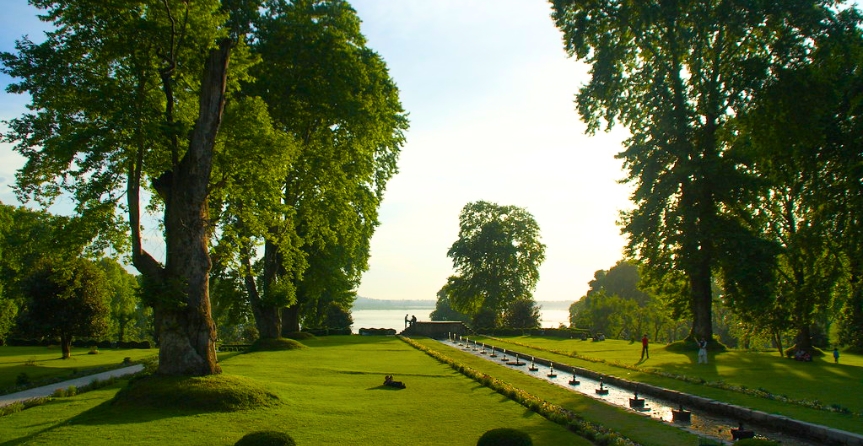
Harwan
On the hillside, south of the village of Harwan (19 km from the Tourist Reception Center), remarkable remains of ancient ornamented tile pavements of the Buddhist period have come to light. The tiles depict the dresses of the people, such as loose trousers, Turkoman caps or close fitting turbans and large ear-rings which reveal Central Asian influence. Besides being an ASI monument site, it also has a beautifully laid out garden in it's vicinity.
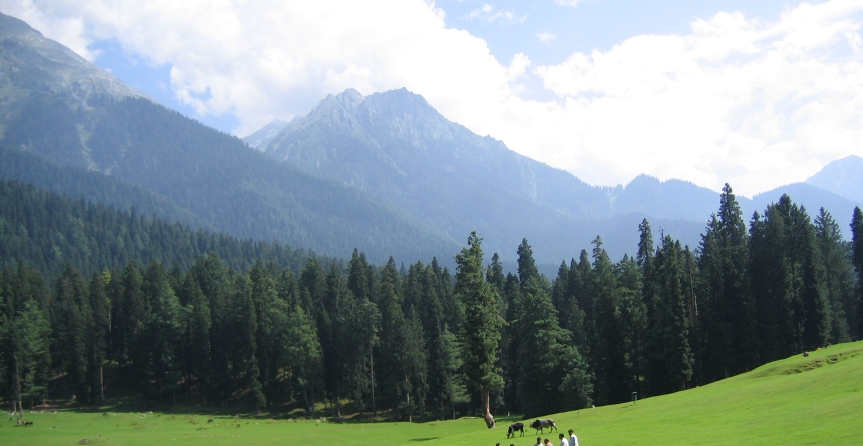
Pahalgam
It is one of the most beautiful valleys in the land of Jammu & Kashmir. Mighty river Lidder flows through the resort and challenges the adventure loving people. The Pahalgam wildlife sanctuary is a major attraction of this place along with the trekking routes. Pahalgam falls enroute to the famous "Amarnath Cave" and serves as a base camp for the same. One can enjoy the mesmerizing beauty of side valleys of Pahalgam also, namely Aru Valley, Chandanwari, Baisaran and Betab Valley. Some other tourist attractions of Pahalgam are:
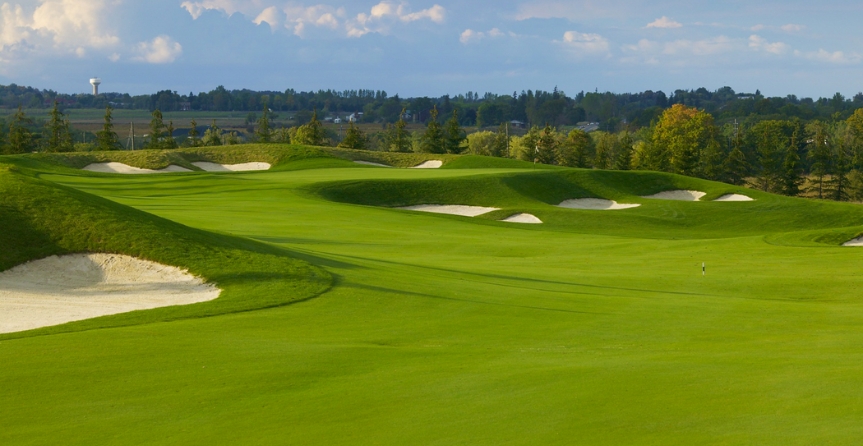
Gulmarg
It is one of the most appreciated tourist spots in Kashmir. The natural beauty of the place is sublime and among the sightseeing spots, the world's highest Gondola and the world's highest golf course are the most famous. The drive to Gulmarg is filled with a number of colors, changing with the season. From the translucent green of spring to summer's rich emerald to autumn's hues, the scenery has something to offer in every season. The "Meadow of Flowers" counts amongst some of the best tourist spots of the world. Gulmarg is famous not only for its awe-inspiring beauty, but for a number of other attractions also. You can also take a Gondola ride (cable car ride), taking the tourists upto Kongdori and Apharwat to enjoy the magnificent sights of the meadow from the top.
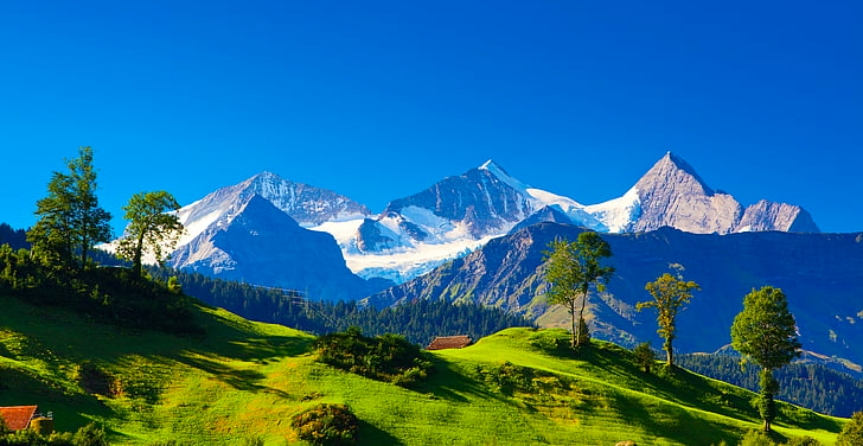
Sonamarg
"Golden Meadow" mesmerizes visitors with its picturesque beauty. The sun rays falling on the snow-capped mountains reflect a golden sparkle, giving the hill station its name. Also this place houses the Thajwas glacier. Sonamarg serves as another base for undertaking the holy yatra of the Amarnath cave. The yatra is organized every year during the month of July-August. In Sonamarg, you will get to try many adventurous sports as well. Some of these are:
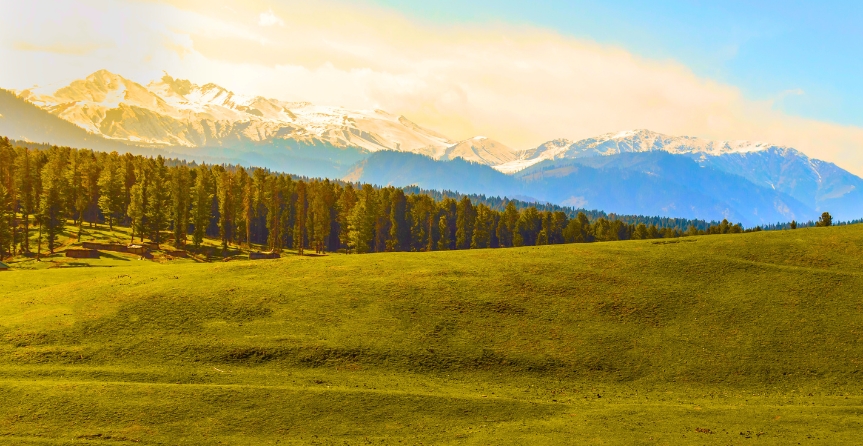
Yusmarg
Yusmarg is approximately 47 km from Srinagar and lies in the Badgam district of Jammu and Kashmir. The two-hour drive to the place is an enjoyment in itself. Grassy pastures stretching to acres of land, the dense forests full of pine trees, with the backdrop of splendid snow-capped mountains leave you almost speechless. Within commutable distance from Srinagar, the capital of Kashmir, Yusmarg is the perfect place to go for a picnic. It is possible that after reaching this place, you may want to even stay for a few days. Specially enchanting for the lovers of long walks in picturesque locales.
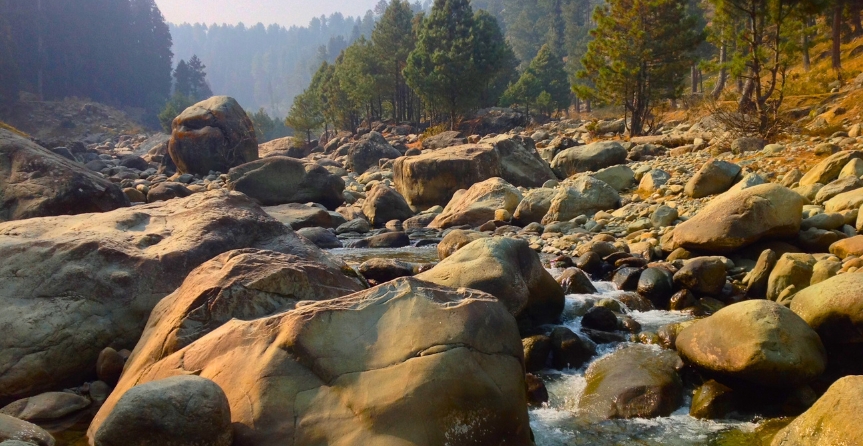
Doodh Pathri
Doodh-e-pathri is yet another bowl shaped valley about 42 km form Srinagar. It is a recent discovery in the valley covered with the green carpeted meadows. The water gushing here resembles the sight of flowing milk. That's how it gets its name oodh-e-pathari. Once here, one can spot herds of cattle grazing in the meadows.
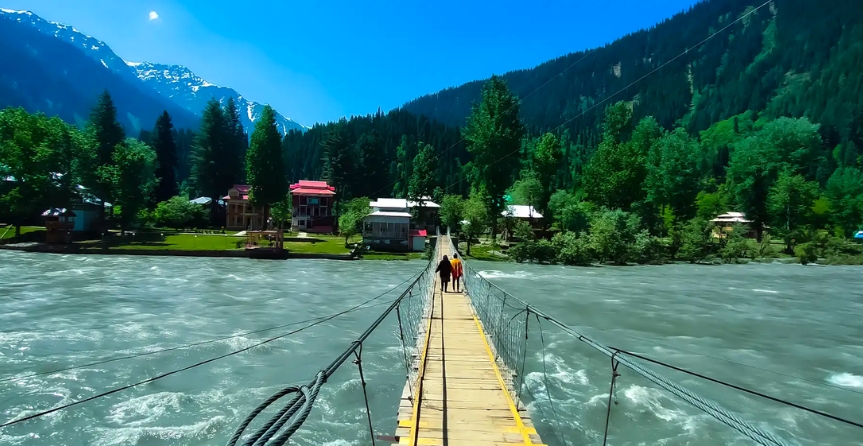
Gurez
Gurez is a valley located in the high Himalayas, about 123 km from Srinagar in Northern Jammu and Kashmir. At about 8,000 feet (2,400 m) above sea level, the valley is surrounded by snow-capped mountains. It has diverse fauna and wildlife including the Himalayan brown bear and the snow leopard. The Kishan Ganga river flows through the valley. The road to Gilgit runs through Gurez. Tourist accommodation is also available at Gurez.
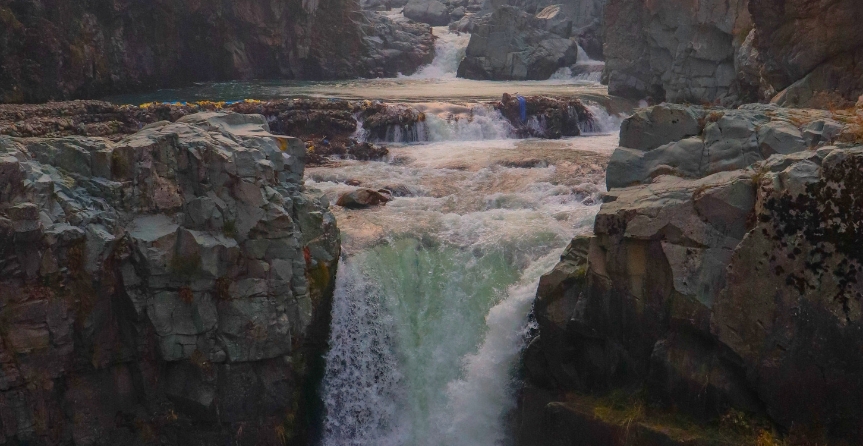
Aharbal
Aharbal fall lies at an altitude of 2500 mtrs. A 70 km journey from Srinagar that passes through world famous apple orchards of Shopian takes you to the mesmerizing fall formed by Veshav River that passes through a gorge. The beauty of the fall attracted even Mughal Emperor Jehangir and his beloved queen Nur Jehan. It is a base camp for Kounsernag (13,500 ft). Source of River Veshav, covered with Glaciers is a lovely attraction for trekkers and mountaineers. The tourist spot is surrounded by lush green meadows and mountains. The spot is accessible from Anantnag via Kulgam (40 km) and Rojouri (75 km). Accommodation is available in Tourist Bungalow, cottages and private guest houses. Don't miss the visit to this spot during your trip to "Paradise on Earth".
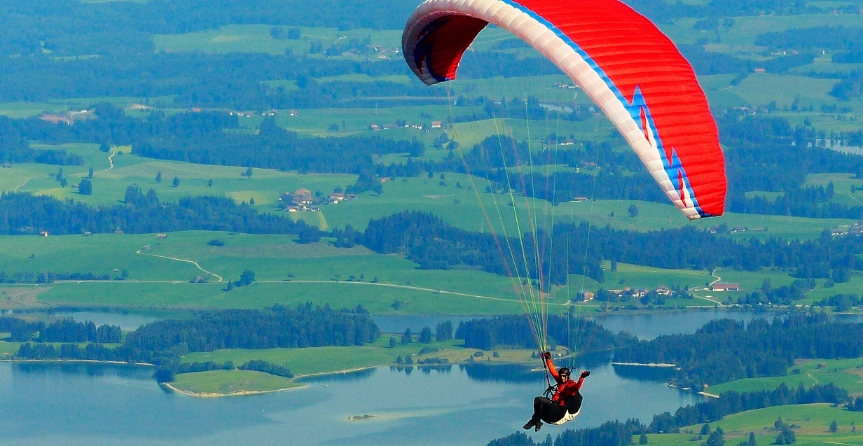
Paragliding is picking up very fast, and is the most popular aero sport in Kashmir. Gliding high above in the sky, along with a marvellous view of the green valleys and majestic mountains of Kashmir, is simply an extraordinary experience. Watching the valley from the sky is a breathtaking experience.
Paragliding is a technical aero sport, in which one glides high above in the air with artificial wings. These wings, made of nylon or Dacron cloth and fabricated into a series of air inflatable cells, weighing about 15 pounds. The entire system is fitted in a corner of the trunk of a car, or on a backpack that one can take with him/her on a hike. The activity sounds thrilling, and is actually fun while performing.
One can avail the adventure clubs at Jammu, Sanasar, Batote, Suru Valley or the Zanskar area to enjoy a number of such sports and challenging activities, including Hot air ballooning or parasailing at an organised level. Apart from such clubs, proper training camps are also organized for amateurs. There are various tourist offices or local agencies that provide equipments for paragliding and other sports on rent. May-June and September-October is the best time to enjoy paragliding in J & K.
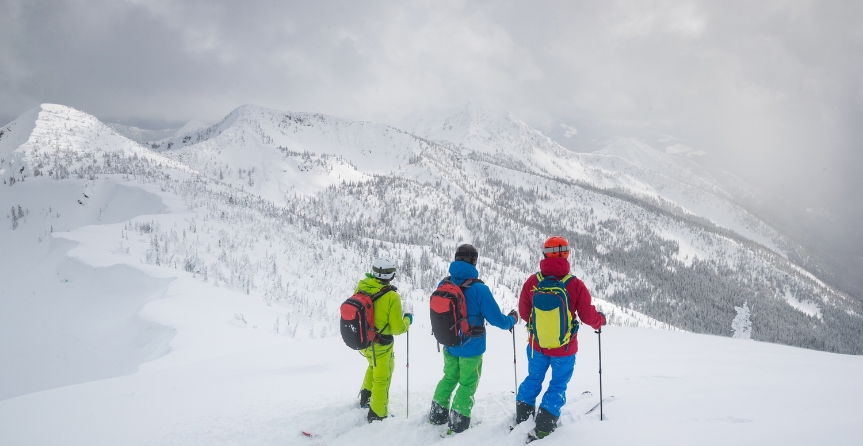
PSkiing is a major sport among adventure enthusiasts that has become one of the most popular recreational activities in this century. Skiing is gaining huge recognition in the state of J&K because of the presence of the mighty Himalayas, a perfect location for this sport.
Sliding over snow with the help of flat runners (skis) - which are attached to the boots or shoes - is an activity that makes your holidays memorable for a lifetime. These skis are used by the skiers to balance their body and maintain velocity.December to April is considered the best season for skiing in Kashmir. Gulmarg, Pahalgam, Patnitop etc. are the important skiing destination in Jammu and Kashmir, where tourists can enjoy the sun and the snow.
The best skiing base in the Himalayas, Gulmarg was first founded by the British in 1927. The town enjoys the position of being one of the highest lift-served as well as cheapest ski resorts in the world. Ideally acceptable for learning skiing, Gulmarg offers a Gandola Cable Car Lift from Gulmarg to Apharwat top. Earlier Gulmarg used to organise two main events, one each during Christmas and Easter. As the sport gained popularity, Gulmarg started hosting National Competitions for the same. The first National Winter Games of India was held at Gulmarg in January-February 1998.
The Ski Club of India was established in Gulmarg in 1927. Located 50 km from Srinagar, at an altitude of 2,730 m, Gulmarg draws ski-lovers from all over the world. While holidaying here, one can try out this activity under the supervision and guidance of trained and experienced instructors. There are several Government-run ski shops, which provide skis, boots, sticks, gloves, goggles and other equipments.
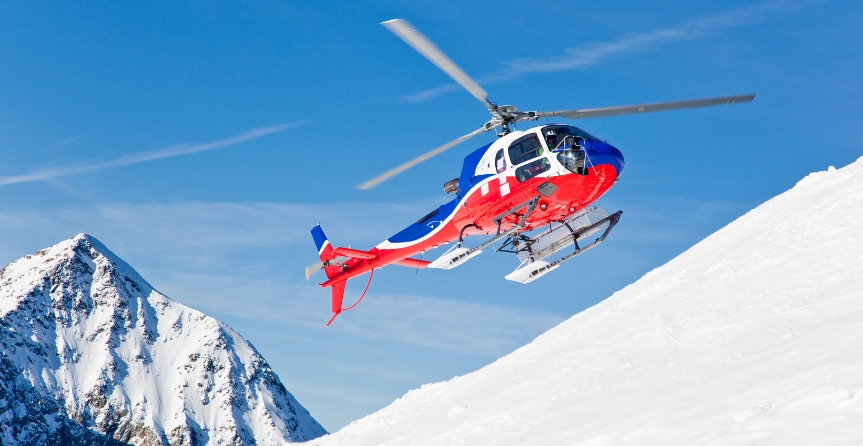
Kashmir boasts of having Asia's only heliskiing resort. Gulmarg, also offers heliskiing for winter sports lovers. Being dropped by a helicopter on the summit of a high, snow-covered peak and then skiing down the slopes is truly an out-of-the-world experience. Heli-skiing is considered the most thrilling, terrifying and risky winter sport.
Apherwat Peak, Gulmarg, is the main heli-skiing base in Kashmir. After Canada, it is the best destination for heli-skiing lovers. This exhilirating sport is a recent addition to Kashmir.
The place offers Toboggans, Sledges, T-Bars & Chair Lifts, and Snow Cycles for various other activities. People also visit the place for fishing, trekking, golfing, water sports and other less adventure activities for a bit of enjoyment and fun.
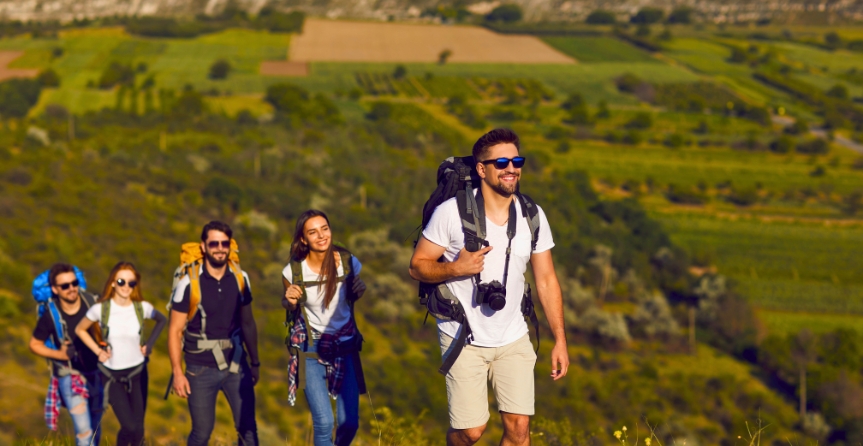
Multi-day hiking trips through mountainous ranges and snow deserts is truly a dream for a trekker. Trekking forms an integral part of the adventure sports flourishing in the hilly tracts of Jammu and Kashmir. The state is an ultimate paradise for trekkers. There are several routes passing through snowy hills, glaciers, and valleys for adventurous trekking. Hemis-Markha-Padum trek (13 days trek) and Chaddar (separating the Indus Valley from Zanskar) are amongst the best and most exciting trek routes in the world. Jammu, Ladakh, Gulmarg, Kishtwar are few places where trekking through the woods and the hills can be enjoyed.
J&K trek routes are categorised as Short Term Treks and Long Term Treks. All the mountainous routes that lie in low altitude regions come under Short term treks. Treks starting from Kishtwar, or Sonamarg – Thajiwas trek, or a few treks starting from Gulmarg are short and perfect for amateurs. Contrary to this, the Amarnath Yatra is one of the most famous long treks in the state. Its duration can be modified depending on how much one want to travel. Apart from this, Gulmarg - Ferozepur Nala, Sudarani - Jungal Gali - Jasar Kote - Sanasar route in the Jungal Gali area, and the Zanskar trek that passes through the Cha Cha La pass and the ancient Karsha Gompa are also some of the best long term treks.
One can find all the facilities and equipments at the base camps, for the convenience of the trekkers. Most of them belong to J&K Tourism Department. The capital Srinagar serves as a base camp for the blue Zabarwan Hills and Shankaracharya Hill. Similarly, Pahalgam (in the Lidder Valley) is the base for treks to the sacred Amarnath, Aru, Lidderwat and the glacial lakes of Tarsar and Tulian; Gulmarg serves as a base camp for treks to the Apharwat and Alpather, the upland lakes of Vishansar and Gangabal and the Thajiwas Glacier; and Sonamarg (in the Sindh Valley) is the base for treks into the surrounding mountains.
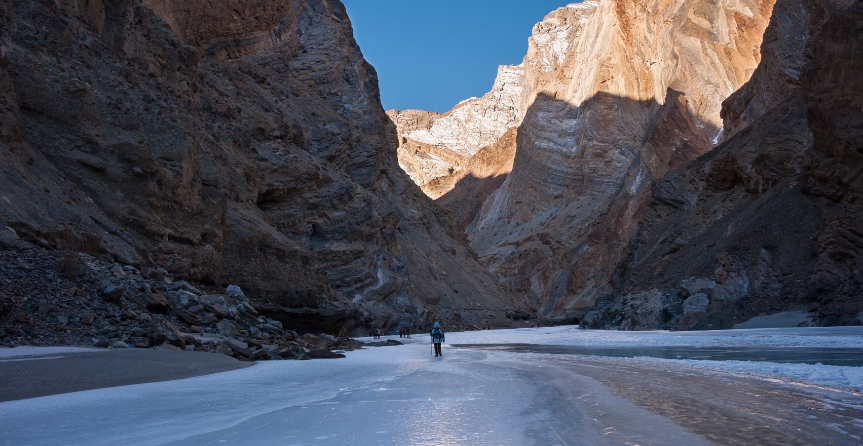
Enfolded between the Himalayas and the Karakoram, Ladakh boasts of being the best destination for trekking in the state of J&K. While trekking in Ladakh, the Frozen Desert, one can spot the huts of Gujjars, wild asses and yaks and some of the largest glaciers in the world outside the polar regions. With the lowest altitude around 11,000 feet, Ladakh offers accommodation in and around all major trek routes. The most convenient way to go trekkin in Ladakh is through a travel agency. The agency takes care of all your camping gear, woolen clothes, equipments and provisions. It also guides and warns you regarding the climate and geography of any particular region.
Equally popular among trekkers and pilgrims, this trek leads to the Amarnath Cave and the naturally formed Ice Shiva-Lingam, one of the holiest pilgrimage for Hindus. Usually completed in five days, this trek passes through Chandanwadi, Sheshnag, Panchtami over the Mahagunas Pass, and Pahalgam.
This excellent trek in the northern Pir Panjal Range offers several viewpoints to enjoy the Nanga Parbat. The trek route in the west leads to Khilanmarg while the south takes you to the Ferozepur Nala and beyond to the hamlets of Danwas, Tejjan, and to Samaidan. Continuing towards south is theSunset Peak and the foothills along the Romushi Nala to Yusmarg.
This low altitude region offers a pleasant scenery of Vishansar, Kishansar, Gadsar, Satsar and Gangabal. The trek in the west crosses the Nichinai pass to Gangabal Lake near Haramukh, which is the highest peak in the vicinity of the Kashmir valley.
The small trek of this beautiful valley at the foot of the Sonmarg glacier leads up to the Shakhdar hill.
Trekking in J&K has always been an experience to cherish. The equipments can be hired from the tourism-board office. Foreign tourists need to submit their passport as security deposit against equipment hired.
Arrange your trip in advance - book this tour now!